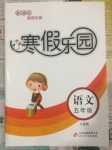题目内容
【题目】 From talking robots and video phones, technology has become so advanced that the previously impossible seems to occur on a daily basis. And yet—we still have no cure for the common cold.
Why can’t we stop the common cold? According to Peter Barlow, a scientist at Edinburgh Napier University, the main challenge lies in the many different types of cold viruses that are produced by the rhinoviruses (鼻病毒). There are at least 160 types. They change so easily that they quickly become resistant to drugs. In other words, a single cure isn’t likely to work on every type of cold.
However, researchers from Stanford University have found a possible answer. They discovered a protein that the viruses need. Without it, they can't spread inside your body.
To identify the gene which produces the specific protein needed by the viruses, researchers used a gene-editing technique to test all genes one by one for thousands of cells. These modified (改变的) cells were then exposed to a range of rhinoviruses which cause the common cold.
All the viruses were unable to copy inside cells without a gene that produces a specific protein, called methyltransferase (甲基转移酶) SETD3.
Then, they tested genetically modified mice, which were completely unable to produce the protein. The mice were able to live healthy, normal lives without the protein.
“Lacking that gene protected the mice completely from the common cold,” associate professor Jan Carette, from Stanford, told the BBC.
“These mice would always die, but they survived and we saw a very strong protection.”
Carette said the plan is to find a drug which can keep back the protein for a limited time, rather than produce genetically modified humans.
“We have identified a fantastic target that all rhinoviruses require and depend on. Take that away and the virus really has no chance,” said Carette.
【1】Why does the author mention talking robots and video phones in the first paragraph?
A.To stress the importance of technology.
B.To encourage readers to share their ideas.
C.To introduce the topic of the text.
D.To recognize the progress of science.
【2】What can we learn about the protein needed by the viruses?
A.It helps the viruses copy inside our bodies.
B.It stops the viruses from changing easily.
C.It protects the viruses against drugs.
D.It forces the viruses to spread fast.
【3】What does Jan Carette intend to do?
A.To identify a fantastic target.
B.To slow copying speed of some genes.
C.To produce genetically modified humans.
D.To find a drug to temporarily block the protein.
【4】What is the best title for the text?
A.A New Experiment on Viruses.
B.New Defense Found for Viruses.
C.A Chemical Curing Modified Viruses.
D.Gene-editing Technology to Control Viruses.
【答案】
【1】C
【2】A
【3】D
【4】B
【解析】
本文是一篇说明文,介绍了研究人员通过试验发现了感冒病毒所需的蛋白质,我们可以通过阻断这种蛋白质来防御感冒病毒。
【1】推理判断题。根据第一段中的“And yet—we still have no cure for the common cold.”可知,尽管技术已经很先进,但是我们仍然没有治愈感冒的方法,再根据第三段中的“However, researchers from Stanford University have found a possible answer. They discovered a protein that the viruses need.”可知,然而,斯坦福大学的研究人员找到了一个可能的答案,他们发现了感冒病毒需要的蛋白质(我们可以通过阻断这种蛋白质来防御感冒病毒),由此可知,第一段提到会说话的机器人和可视电话就是为了引出文章主题——我们发现了防御感冒病毒的新方法,故C项正确。
【2】推理判断题。根据第五段“All the viruses were unable to copy inside cells without a gene that produces a specific protein, called methyltransferase (甲基转移酶) SETD3.”可知,所有这些病毒都无法在细胞内复制,因为它们体内没有产生一种特殊蛋白质的基因,这种蛋白质被称为甲基转移酶SETD3,由此可知这种蛋白质有助于病毒在我们体内复制,故A项正确。
【3】细节理解题。根据倒数第二段中的“Carette said the plan is to find a drug which can keep back the protein for a limited time,”可知,简·卡蕾特说,他们的计划是找到一种能在有限时间内阻断这种蛋白质的药物,也就是说,简·卡蕾特打算找到一种药物来暂时阻断蛋白质,故D项正确。
【4】主旨大意题。通读全文,特别是根据第三段中的“They discovered a protein that the viruses need.”及最后一段内容可知,本文主要介绍了研究人员通过试验发现了感冒病毒所需的蛋白质,我们可以通过阻断这种蛋白质来防御感冒病毒,故B项正确。

 寒假乐园北京教育出版社系列答案
寒假乐园北京教育出版社系列答案